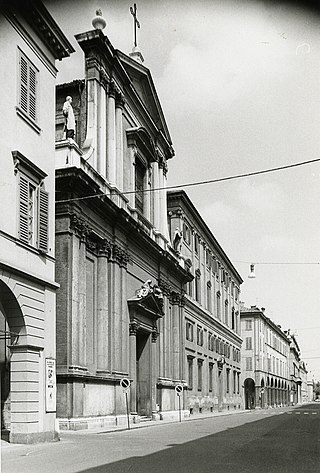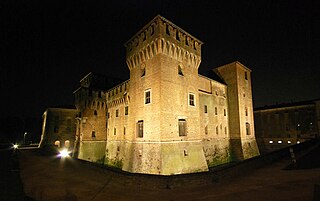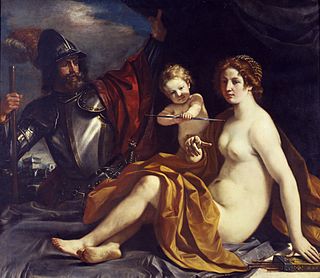
Modena is a city and comune (municipality) on the south side of the Po Valley, in the Province of Modena, in the Emilia-Romagna region of northern Italy.

The Duchy of Modena and Reggio was an Italian state created in 1452 located in Northwestern Italy, in the present day region of Emilia-Romagna. It was ruled since its establishment by the noble House of Este, and since 1814 by the Austria-Este branch of the family. The Este dynasty was a great sponsor of the arts, making the Duchy a cultural reference during the Renaissance and Baroque periods.

Niccolò dell'Abbate, sometimes Nicolò and Abate was a Mannerist Italian painter in fresco and oils. He was of the Emilian school, and was part of the team of artists called the School of Fontainebleau that introduced the Italian Renaissance to France. He may be found indexed under either "Niccolò" or "Abbate", though the former is more correct.

Palazzo Schifanoia is a Renaissance palace in Ferrara, Emilia-Romagna (Italy) built for the Este family. The name "Schifanoia" is thought to originate from "schivar la noia" meaning literally to "escape from boredom" which describes accurately the original intention of the palazzo and the other villas in close proximity where the Este court relaxed. The highlights of its decorations are the allegorical frescoes with details in tempera by or after Francesco del Cossa and Cosmè Tura, executed ca 1469–70, a unique survival of their time.

Sassuolo is an Italian town, comune, and industrial centre of the Province of Modena in Emilia-Romagna.

The Palazzo Ducale di Mantova is a group of buildings in Mantua, Lombardy, northern Italy, built between the 14th and the 17th century mainly by the noble family of Gonzaga as their royal residence in the capital of their Duchy. The buildings are connected by corridors and galleries and are enriched by inner courts and wide gardens. The complex includes some 500 rooms and occupies an area of c. 34,000 m2, which make it the sixth largest palace in Europe after the palaces of the Vatican, the Louvre Palace, the Palace of Versailles, the Royal Palace of Caserta and the Castle of Fontainebleau. It has more than 500 rooms and contains seven gardens and eight courtyards. Although most famous for Mantegna's frescos in the Camera degli Sposi, they have many other very significant architectural and painted elements.

The Castello Estense or castello di San Michele is a moated medieval castle in the center of Ferrara, northern Italy. It consists of a large block with four corner towers.

The Camera degli Sposi, sometimes known as the Camera picta, is a room frescoed with illusionistic paintings by Andrea Mantegna in the Ducal Palace, Mantua, Italy. During the fifteenth century when the Camera degli Sposi was painted, Mantua was ruled by the Gonzaga, who maintained Mantua's political autonomy from its much stronger neighbors Milan and Venice by bidding their support out as a mercenary state. By commissioning Mantegna to paint the chamber, Ludovico III Gonzaga, the Marquis of Mantua, sought to give the Gonzaga rule more cultural credibility at a time when other Northern Italian courts such as the Ferrara were commissioning their own “painted chambers”.
Giulio d'Este was the illegitimate son of Ercole I d'Este, Duke of Ferrara. He is known for the conflicts he had with his half brother, Ippolito d'Este, which culminated in a failed conspiracy.
The Ducal Palace of Modena is a Baroque palace in Modena, Italy. It was the residence of the Este Dukes of Modena between 1452 and 1859. It currently houses a portion of the Italian Military Academy.

The Galleria Estense is an art gallery in the heart of Modena, centred around the collection of the d’Este family: rulers of Modena, Reggio and Ferrara from 1289 to 1796. Located on the top floor of the Palazzo dei Musei, on the St. Augustine square, the museum showcases a vast array of works ranging from fresco and oil painting to marble, polychrome and terracotta sculpture; musical instruments; numismatics; curios and decorative antiques.

The church of San Vincenzo is a Baroque style, Roman Catholic church located on Corso Canalgrande, number 75 in Modena, Italy.

The Castello di San Giorgio is part of the Ducal palace of Mantua. It is a moated rectangular castle, each of which's four corners has a large tower and the moat is crossed by three drawbridges.
The Gallerie Estensi is a network of three museums and a library, bringing together the collective fruits of artistic production from Ferrara, Modena and Sassuolo in the Emilia-Romagna region of Northern Italy. The galleries aim to preserve the historic heritage left by the influential House of Este, with a focus on relating their noble past to the local communities at each site.

The Pinacotecta Nazionale is an art gallery in Ferrara, Emilia-Romagna, Italy. It is located on the piano nobile of the Palazzo dei Diamanti, a work of Renaissance architecture by Biagio Rossetti, commissioned by Leonello d’Este in 1447. Not to be confused with the Civic Museum on the lower floor, which has hosted temporary exhibitions of contemporary art since 1992, the Pinacoteca houses a collection of paintings by the Ferrarese School dating from the thirteenth to the eighteenth centuries. It was founded in 1836 by the Municipality of Ferrara after Napoleon's widespread dissolution of churches threatened the protection of important public artworks. The gallery is formed as much around notable northern Italian painters as it is around the exquisite interior decoration of the palace itself, together with remnants of frescoes from local churches and later acquisitions from the Sacrati Strozzi collection.

The Estense Lapidary Museum is a lapidarium-museum in Modena, Italy, located around the interior quadrangle of the Palazzo dei Musei's ground floor. It is owned by the province of Modena and the Gallerie Estensi. As the first public museum to be commissioned by the Duke Francesco IV d'Este upon his re-entry into Modena in 1814, it stands as a symbol of the collaboration between church, state and nobility. It also marks a new direction for the city of Modena, one recognising its rich historical identity.

Venus, Cupid and Mars is a 1633 oil-on-canvas painting by the Italian Baroque painter Guercino, commissioned by Francesco I d'Este for his Ducal Palace of Sassuolo around 1632–1633, when the artist was in that city to paint portraits of the d'Este family. It is now in the Galleria Estense in Modena.

The Palazzo Contrari is a building of mediaeval origin located in Ferrara in Via Contrari, at no. 5, in the city centre, next to the Palazzo di San Crispino.

The Municipal Palace of Ferrara is located in Piazza del Municipio 2. It was the ducal residence of the Este family until the 16th century, when the court moved to the nearby Castello Estense. It is the seat of the municipality of Ferrara.

The ‘‘‘Ducal Palace of Rivalta’’’ was a baroque palace in Rivalta, just south of Reggio Emilia, Itay. The palace and its park were inspired by the Palace of Versailles. Until 1796, it served as a residence of the dukes of Modena from the House of Este, after which it fell in disrepair. Today, only the southern wing remains.






























